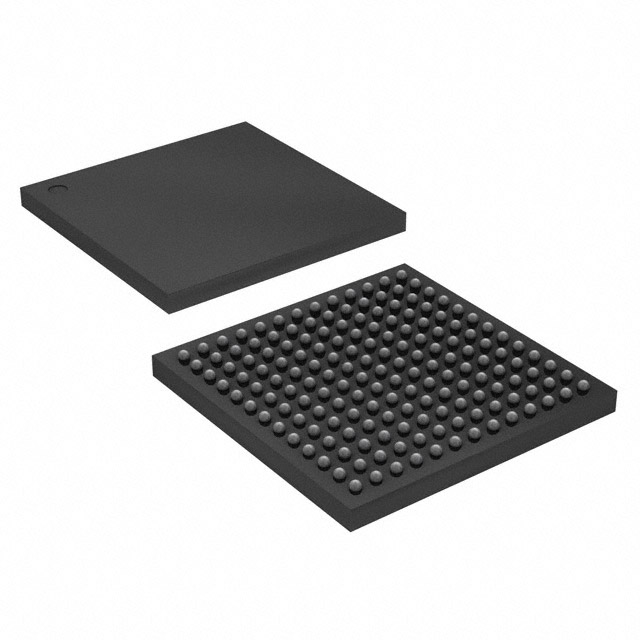Xem thông số kỹ thuật để biết chi tiết sản phẩm.

10M08SCU169I7G
Basic Information Overview
- Category: Integrated Circuit (IC)
- Use: Programmable Logic Device (PLD)
- Characteristics: High-performance, low-power consumption, reprogrammable
- Package: Small Outline Integrated Circuit (SOIC)
- Essence: This IC is designed to provide programmable logic functions for various applications.
- Packaging/Quantity: Typically sold in reels or tubes containing multiple units.
Specifications
- Technology: 65nm Flash-based CMOS
- Logic Elements: 8,000
- Maximum User I/Os: 169
- Speed Grade: I7G (Industrial grade, speed grade 7)
- Operating Voltage: 1.2V
- Operating Temperature Range: -40°C to +85°C
Detailed Pin Configuration
The 10M08SCU169I7G IC has a total of 169 pins, each serving a specific function. The pin configuration includes input/output pins, power supply pins, ground pins, and configuration pins. A detailed pinout diagram can be found in the datasheet provided by the manufacturer.
Functional Features
- High-density programmable logic device with advanced flash-based technology.
- Supports various programmable logic functions such as combinatorial and sequential logic.
- Offers flexible I/O options for interfacing with external devices.
- Low-power consumption design for energy-efficient operation.
- Reprogrammable nature allows for easy updates and modifications.
Advantages
- Versatile and adaptable for a wide range of applications.
- High-performance capabilities enable complex logic designs.
- Low-power consumption helps reduce overall system energy requirements.
- Reprogrammability allows for iterative development and debugging.
- Compact package size makes it suitable for space-constrained designs.
Disadvantages
- Limited number of logic elements compared to larger PLDs.
- Higher cost per logic element compared to larger PLDs.
- Requires specialized programming tools and knowledge for configuration.
Working Principles
The 10M08SCU169I7G operates based on the principles of programmable logic. It consists of a matrix of configurable logic elements interconnected through programmable interconnects. These logic elements can be programmed to implement various logical functions, such as AND, OR, XOR, etc. The configuration data is stored in non-volatile memory cells, allowing the device to retain its programmed functionality even after power-off.
Detailed Application Field Plans
The 10M08SCU169I7G IC finds applications in various fields, including but not limited to: 1. Industrial automation: Control systems, motor drives, and sensor interfacing. 2. Communications: Data routers, network switches, and protocol converters. 3. Consumer electronics: Set-top boxes, gaming consoles, and multimedia devices. 4. Automotive: Engine control units, infotainment systems, and driver assistance. 5. Medical devices: Patient monitoring systems, diagnostic equipment, and imaging devices.
Detailed and Complete Alternative Models
- 10M02SCU169C8G: Similar PLD with lower logic capacity and different speed grade.
- 10M16SCU256I7G: Similar PLD with higher logic capacity and same speed grade.
- 10M08SAE144C8G: Alternative PLD with different package and pin configuration.
Note: This entry provides a brief overview of the 10M08SCU169I7G IC. For more detailed information, please refer to the datasheet provided by the manufacturer.
Word Count: 410
Liệt kê 10 câu hỏi và câu trả lời thường gặp liên quan đến ứng dụng 10M08SCU169I7G trong giải pháp kỹ thuật
Sure! Here are 10 common questions and answers related to the application of 10M08SCU169I7G in technical solutions:
1. What is 10M08SCU169I7G? - 10M08SCU169I7G is a specific model number of an FPGA (Field-Programmable Gate Array) manufactured by Intel.
2. What are the key features of 10M08SCU169I7G? - Some key features of 10M08SCU169I7G include low power consumption, high-performance processing capabilities, embedded memory blocks, and programmable logic elements.
3. How can 10M08SCU169I7G be used in technical solutions? - 10M08SCU169I7G can be used in various technical solutions such as digital signal processing, industrial automation, robotics, telecommunications, and embedded systems.
4. What programming languages are supported for programming 10M08SCU169I7G? - 10M08SCU169I7G can be programmed using hardware description languages (HDLs) like VHDL or Verilog, as well as higher-level languages like C/C++ through Intel's Quartus Prime software.
5. Can 10M08SCU169I7G be reprogrammed after deployment? - Yes, 10M08SCU169I7G is a field-programmable device, which means it can be reprogrammed even after it has been deployed in a system.
6. What are the advantages of using 10M08SCU169I7G in technical solutions? - Some advantages of using 10M08SCU169I7G include flexibility, scalability, faster time-to-market, lower development costs, and the ability to customize hardware functionality.
7. What is the power consumption of 10M08SCU169I7G? - The power consumption of 10M08SCU169I7G depends on various factors such as the design complexity, clock frequency, and utilization. It is recommended to refer to the device datasheet for specific power consumption details.
8. Can 10M08SCU169I7G interface with other components or devices? - Yes, 10M08SCU169I7G can interface with other components or devices through its I/O pins, which can be configured to support various communication protocols like UART, SPI, I2C, Ethernet, etc.
9. Are there any development boards available for prototyping with 10M08SCU169I7G? - Yes, Intel provides development boards like the Terasic DE10-Lite, which feature the 10M08SCU169I7G FPGA, allowing developers to prototype and test their designs.
10. Where can I find more information about 10M08SCU169I7G and its applications? - You can find more information about 10M08SCU169I7G, its datasheet, application notes, and reference designs on Intel's official website or by referring to relevant technical documentation and forums.

